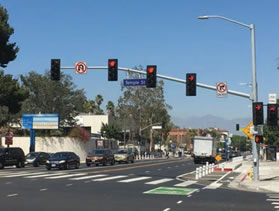Automated Traffic Signal Performance MeasuresEvery Day Counts: An Innovation Partnership with States"Automated traffic signal performance measures (ATSPM) will revolutionize the management of traffic signals by providing the high-resolution data needed to actively manage performance." Source: EDC-4 Final Report  Photo Credit: Adobe Stock
Photo Credit: Adobe Stock
Every Day Counts focuses on accelerating project delivery and deploying proven innovations that facilitate greater efficiency at State and local levels to deliver the greatest value for tax dollars spent. Every Day Counts (EDC) is a Federal Highway Administration (FHWA)program that works in partnership with the American Association of State Highway and Transportation Officials (AASHTO) and other transportation stakeholders to foster a culture of innovation.1 It focuses on accelerating project delivery and deploying proven innovations that facilitate greater efficiency at State and local levels. EDC is designed to complement other initiatives promoting innovative technologies and practices, playing an important role in helping transportation agencies fulfill their obligation to the American people— deliver the greatest value from tax dollars spent. As detailed in this report, round four of Every Day Counts (EDC-4) championed the deployment of ATSPM through a series of workshops, webinars, and case studies. These activities raised awareness of the capabilities of ATSPM and facilitated the exchange of information between peers and practitioners. FHWA has also been active in facilitating ATSPM through State Transportation Innovation Councils (STIC) and Accelerated Innovation Deployment (AID) grants, including the following.  Photo Credit:FHWA
Photo Credit:FHWA
STIC Incentive Program: This program offers assistance and funds to support the cost of standardizing innovative practices in a state transportation agency or by other public sector STIC stakeholders. Projects were awarded to Maine, Missouri, North Carolina, and Louisiana to facilitate ATSPM deployment. Tennessee received program funding for traffic signal operations.  Photo Credit: Adobe Stock
Photo Credit: Adobe Stock
AID Demonstration Program: This program provides funding as an incentive for eligible entities to accelerate the implementation and adoption of innovation in highway transportation. AID Demonstration Grants for ATSPM implementation include: Selected innovations share common goals:
For a comprehensive overview of all EDC-4 innovations, please visit the EDC-4 Innovations webpage and the EDC-4 Final Report referenced at: https://www.fhwa.dot.gov/innovation/everydaycounts/edc-4.cfm https://www.fhwa.dot.gov/innovation/everydaycounts/reports/edc4_final/ 1 Section 1444 of the Fixing America’s Surface Transportation Act (Public Law 114-94) (23 U.S.C. 101 note) [ Return to Note 1 ] |
|
United States Department of Transportation - Federal Highway Administration |
||